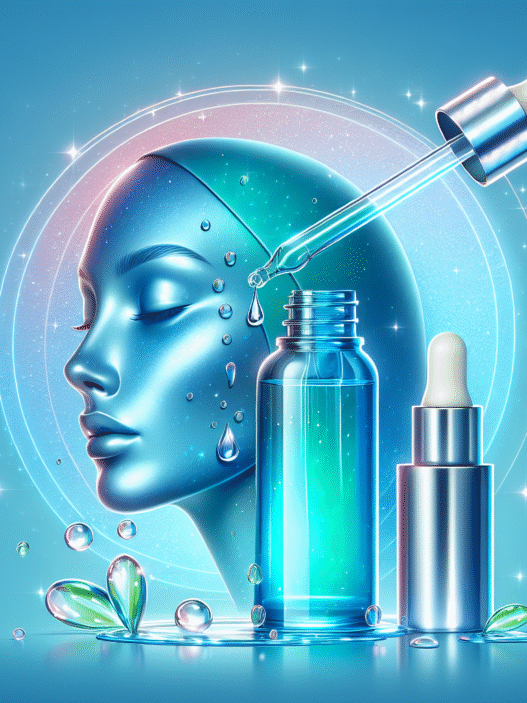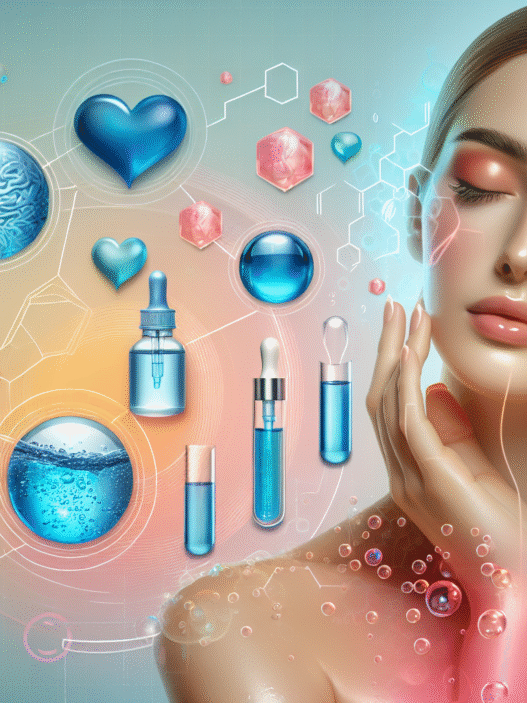Understanding Hyaluronic Acid
Function and Importance
Hyaluronic acid (HA) is a vital molecule that plays a crucial role in maintaining youthful skin. It possesses a unique ability to retain water, which is essential for skin hydration. This compound is primarily responsible for the turgor, resilience, and pliability of the skin, contributing to a youthful appearance. As it aids in moisture retention, HA ensures that the skin remains soft, plump, and hydrated, thereby preventing signs of aging, such as wrinkles and sagging skin (PMC).
In the human body, hyaluronic acid is an essential component of the extracellular matrix, which supports skin structure and function. Its loss begins around the age of 25, which can lead to decreased moisture levels and the beginning of visible aging symptoms. The increased focus on HA in dermatology since the 1970s has underscored its potential in skincare and cosmetic procedures.
Distribution in the Body
Hyaluronic acid is widely distributed throughout the human body, with approximately 50% of the total body HA found in the skin. It is also present in joints, connective tissues, and other fluids, where it fulfills various roles, including cushioning joints and aiding in tissue hydration.
| Body Tissue | Percentage of Total HA |
|---|---|
| Skin | 50% |
| Other Tissues and Fluids | 50% |
This molecular distribution highlights its significance beyond merely skin hydration, indicating its versatility in applications related to joint health, wound healing, and even medical procedures like eye surgery (Source).
Due to its various benefits and the numerous applications of hyaluronic acid—from hyaluronic acid serums to injections—it has become an integral part of beauty and health regimens. Understanding its function and distribution helps beauty and skincare enthusiasts appreciate why hyaluronic acid is paramount for achieving and maintaining youthful skin.
Benefits of Hyaluronic Acid
Hyaluronic acid (HA) serves a multitude of roles in promoting youthful skin. It is renowned among beauty and skincare enthusiasts for its remarkable hydrating properties, anti-aging effects, and wound healing capabilities. Here’s a closer look at these benefits.
Skin Hydration
One of the primary benefits of hyaluronic acid is its ability to increase skin moisture levels. HA can hold up to 1,000 times its weight in water, making it exceptionally effective as a hydrator. This unique property allows hyaluronic acid to keep skin hydrated for extended periods, targeting both the stratum corneum and the dermis.
Proper hydration contributes to skin elasticity and plumpness, making it a cornerstone in maintaining a youthful appearance. Regular use of HA in skincare products, such as hyaluronic acid serum or hyaluronic acid moisturizer, can significantly improve skin hydration levels.
| Attribute | Details |
|---|---|
| Water Retention Capacity | 1,000 times its weight in water |
| Penetration Depth | Stratum corneum and dermis |
| Product Forms | Serum, moisturizer, cream |
Anti-aging Effects
Hyaluronic acid is widely recognized for its anti-aging properties. By increasing moisture content in the skin, it helps reduce the appearance of fine lines and wrinkles. The penetration ability of HA varies with different molecular weights, allowing more targeted treatment of skin concerns. Higher molecular weight HA has greater viscosity and holds more water, while lower molecular weight HA penetrates deeper into the skin to trigger biological pathways necessary for rejuvenation.
Incorporating HA into a skincare routine can effectively combat the visual signs of aging. Products infused with hyaluronic acid and collagen can enhance overall skin firmness and elasticity, further enhancing the look of youthfulness.
| Benefit | Description |
|---|---|
| Reduces Fine Lines | Fills in and plumps the skin |
| Increases Elasticity | Enhances skin firmness and structure |
| Improves Texture | Results in smoother and softer skin |
Wound Healing Properties
Hyaluronic acid also plays a crucial role in wound healing. It is naturally present in the body, particularly in connective tissues, where it aids in tissue repair and regeneration. By attracting moisture to the site of injury, HA promotes a healing environment and helps reduce scars (Healthline).
This property makes HA a popular ingredient in various therapeutic and cosmetic treatments. For individuals seeking to improve their skin healing process, options like hyaluronic acid injections can provide significant advantages during the recovery phase.
| Healing Attribute | Function |
|---|---|
| Moisture Attraction | Keeps the wound hydrated |
| Tissue Repair | Aids in faster healing and reduces scars |
| Skin Regeneration | Promotes the cellular turnover process |
These benefits underscore the importance of hyaluronic acid in achieving and maintaining youthful skin. Whether used topically or through injectable treatments, hyaluronic acid continues to be a key component in the quest for healthier, more vibrant skin. For those interested in maximizing these advantages, products featuring HA can be explored further in the context of their benefits, especially regarding hyaluronic acid and anti-aging solutions.
Types and Applications of Hyaluronic Acid
Hyaluronic acid is available in various forms and applications, each contributing uniquely to skin health and hydration. This section explores the differences between topical application and oral consumption, the significance of molecular weights, and the various formulations of hyaluronic acid found in skincare products.
Topical Application vs. Oral Consumption
Hyaluronic acid can be applied topically as well as taken orally. Research has shown that topical hyaluronic acid is effective and well-tolerated for skin aging, particularly after facial or postsurgical rejuvenation procedures (Medical News Today). A study demonstrated significant improvements in skin hydration among females aged 30 to 65 who applied topical hyaluronic acid twice daily for six weeks. Participants notably reported enhancements in skin hydration and elasticity over this period.
Oral consumption of hyaluronic acid can also benefit overall skin health, flexibility, and elasticity, particularly when taken as a long-term supplement.
| Application Type | Benefits |
|---|---|
| Topical Application | Improves hydration, elasticity, and skin aging effects |
| Oral Consumption | Enhances overall skin health and elasticity, long-term benefits |
Different Molecular Weights
Hyaluronic acid comes in varying molecular weights, which influence its properties and functions in skincare. It is crucial to understand these variations to optimize applications in products aimed at enhancing skin health. Studies have indicated that the most effective molecular weight range for skin is between 50 to 1,000 kDa, with approximately 130 kDa being particularly beneficial. Hyaluronic acid at this weight has shown to increase skin elasticity by up to 20%. However, larger molecules (greater than 500 kDa) struggle to penetrate the skin barrier effectively.
| Molecular Weight (kDa) | Benefits |
|---|---|
| 50 – 1,000 | Varied, effective penetrability |
| 130 | Increases skin elasticity by 20% |
| >500 | Limited penetration |
Formulations in Skincare Products
Hyaluronic acid is available in multiple formulations within skincare products, each offering unique benefits. These include raw hyaluronic acid, hydrolyzed hyaluronic acid, alkaline hyaluronic acid, cross-linked hyaluronic acid, and acetylated hyaluronic acid. Each form serves distinct purposes, targeting skin hydration, anti-aging effects, and collagen protection (Typology).
Skincare products containing variations such as hydrolyzed hyaluronic acid and low molecular weight hyaluronic acid salts are especially popular for their moisturizing and anti-aging properties.
| Formulation Type | Key Benefits |
|---|---|
| Raw Hyaluronic Acid | Basic hydration |
| Hydrolyzed Hyaluronic Acid | Enhanced absorption |
| Alkaline Hyaluronic Acid | Improved stability in products |
| Cross-Linked Hyaluronic Acid | Longer-lasting hydration effects |
| Acetylated Hyaluronic Acid | Better retention in skin layers |
Through an understanding of the available types and applications of hyaluronic acid, beauty and skincare enthusiasts can make informed decisions about incorporating this powerful ingredient into their routines. For detailed insights on the benefits of hyaluronic acid, refer to our article on hyaluronic acid benefits.
Effectiveness and Safety of Hyaluronic Acid
Hyaluronic acid is widely known for its benefits in skincare, particularly for promoting youthful skin. Understanding its efficacy and safety is crucial for beauty enthusiasts.
Research Findings on Efficacy
Numerous studies underline the effectiveness of hyaluronic acid in skincare. A 2022 review highlighted that topical hyaluronic acid serves as an effective and well-tolerated treatment for aging skin, particularly after facial or postsurgical rejuvenation procedures. Furthermore, another study demonstrated that when applied twice daily, topical hyaluronic acid improved skin hydration in women aged 30 to 65 with signs of photoaging, with noticeable improvements reported after six weeks.
Additionally, a 2023 study revealed that oral hyaluronic acid not only enhanced skin hydration but also improved skin tone and epidermal thickness in a diverse group of 123 women across various ages and skin types (Medical News Today). Long-term use, whether through serums or supplements, contributes positively to overall skin health, flexibility, and elasticity (Cleveland Clinic).
Safety Considerations
Hyaluronic acid is generally recognized as safe for topical and oral use. Adverse reactions are rare, and it is often well-tolerated by people with various skin types. However, as the body’s natural production of hyaluronic acid decreases with age—around 6% per decade—this lack can lead to skin issues such as slackening and increased wrinkles (Typology). Dermocosmetic applications do provide a safe alternative to invasive procedures, allowing individuals to replenish this vital compound without significant risk.
Nonetheless, individuals should be mindful of the products they choose, opting for those formulated with quality ingredients. Consulting a dermatologist is advisable for anyone considering hyaluronic acid injections or extensive usage.
Proper Usage Recommendations
For optimal results when using hyaluronic acid, it is important to adhere to specific guidelines:
- Application Frequency: Use topical formulations such as hyaluronic acid serums twice daily, ideally after cleansing the skin.
- Layering Products: Always apply a moisturizer on top of the serum to lock in hydration effectively. A high-quality hyaluronic acid moisturizer will enhance benefits.
- Hydration: For oral supplements, follow the recommended dosages on the product label to ensure safety and efficacy. Hyaluronic acid supplements may also contribute to overall hydration and skin elasticity.
Following these guidelines can help beauty enthusiasts maximize the benefits of hyaluronic acid in promoting youthful skin. Additional information about the effects of hyaluronic acid can be found by exploring links related to hyaluronic acid and skin care and its role in anti-aging effects.
Clinical Applications of Hyaluronic Acid
Hyaluronic acid has broad applications in various clinical settings, showcasing its versatility beyond skincare. This section explores its use in joint health, cosmetic procedures, and medical treatments.
Joint Health
Hyaluronic acid plays a significant role in joint health. It is often injected to relieve knee pain in individuals with mild to moderate osteoarthritis. The FDA approves these injections as they are considered generally safe and effective when other treatments have not worked. Although hyaluronic acid injections can lead to temporary side effects such as local swelling and pain, these typically resolve within a few days after treatment.
| Application | Condition | FDA Approval Status | Common Side Effects |
|---|---|---|---|
| Hyaluronic Acid Injections | Knee Pain (Osteoarthritis) | Approved | Local swelling, pain |
Cosmetic Procedures
In the realm of cosmetic enhancements, hyaluronic acid is widely known as a key ingredient in dermal fillers. These fillers help to repair or conceal scars, particularly those left by acne, and can also enhance facial volume, providing a plump look. The hydration and anti-aging properties of hyaluronic acid make it an essential component in various aesthetic treatments. A study indicates that topical hyaluronic acid, when paired with Botulinum toxin type A, significantly improves signs of facial aging and overall skin quality, leading to high satisfaction among patients.
Medical Treatments
Hyaluronic acid is gaining traction in medical treatments beyond cosmetic uses. It is utilized in cosmeceuticals for its hydrating and anti-aging effects, proving effective and well-tolerated in conjunction with both post-surgical care and facial rejuvenation procedures. Clinical studies have supported the efficacy of hyaluronic acid formulations in improving skin hydration and rejuvenation, making it a popular ingredient in many skincare products.
| Medical Application | Purpose | Effectiveness | Research Status |
|---|---|---|---|
| Hyaluronic Acid in Cosmeceuticals | Hydration and anti-aging | Well-tolerated and effective | Supported by several clinical studies |
Each of these applications highlights the multifaceted benefits of hyaluronic acid, making it a touchstone in the quest for youthful skin and overall health. For more detailed insights into hyaluronic acid’s benefits, check our article on hyaluronic acid benefits.
Hyaluronic Acid in the Market
Global Demand and Economic Impact
The demand for hyaluronic acid products has seen significant growth, driven by its versatility and numerous applications in both cosmetic and medical industries. The global market for finished hyaluronic acid (HA) products was estimated at around $20 billion in 2019, according to market research from Grand View Research. This figure underscores the economic impact and consumer interest in products harnessing the benefits of hyaluronic acid for youthful skin and overall health.
Hyaluronic acid is widely used in topical skincare products due to its hydrating properties, making it a staple ingredient in serums and moisturizers. Additionally, it is utilized in medical settings for applications such as dermal fillers for cosmetic procedures and injections for joint health, particularly for osteoarthritis treatment (Source).
| Year | Global Market Value (in billion USD) |
|---|---|
| 2019 | 20 |
| 2025 (Projected) | 30+ |
| 2030 (Projected) | 40+ |
Production Costs
The production costs of hyaluronic acid can vary significantly based on the source and manufacturing methods used. Hyaluronic acid can be derived from animal tissue or produced synthetically through fermentation processes. The synthetic method is becoming increasingly favored for its purity and ethical considerations. Production costs may rise with advancements in technology, but the continuous demand for HA in skincare and medical applications keeps the market competitive.
| Source | Average Production Cost (per gram) |
|---|---|
| Animal-Derived | $0.15 – $0.30 |
| Bacterial Fermentation | $0.20 – $0.35 |
Investments in research and development aimed at improving production efficiency may further influence costs in the future.
Market Trends and Future Prospects
The future of the hyaluronic acid market looks promising, as trends indicate a growing consumer preference for products containing natural and effective ingredients. The rise in awareness about the anti-aging benefits of hyaluronic acid has led to increased product releases in both topical and injectable forms.
Key trends impacting the market include:
- Clean Beauty Movement: Consumers are increasingly demanding formulations that are free from harmful chemicals and focus on natural, effective ingredients, leading to a greater interest in hyaluronic acid.
- Personalized Skincare: Tailoring products based on individual skin needs is becoming popular, with hyaluronic acid being a favored ingredient due to its universal compatibility with various skin types.
- Diverse Applications: As research continues to uncover new benefits of hyaluronic acid, its applications are expected to expand into emerging markets such as hair care and advanced wound healing, further driving market growth.
With these trends and a strong foundation in place, the hyaluronic acid market is projected to continue its upward trajectory, making it a significant player in the future of beauty and healthcare industries. For more details on the benefits of hyaluronic acid, refer to our article on hyaluronic acid benefits.





















